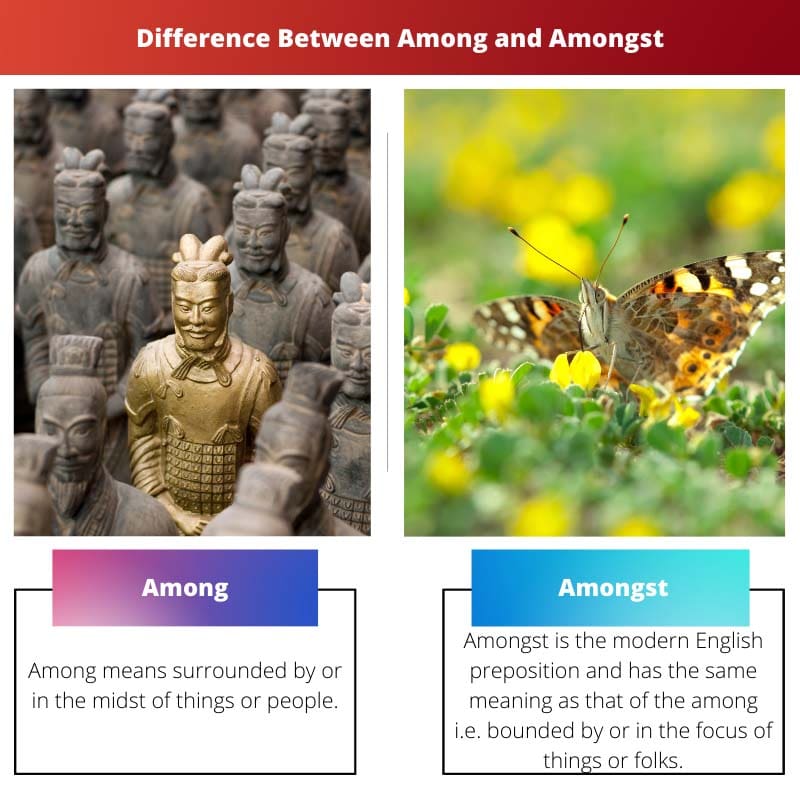“Among” and “amongst” are both prepositions used to indicate being surrounded by, included in, or in the midst of something. While “among” is more commonly used in American English, “amongst” is frequently employed in British English.
ประเด็นที่สำคัญ
- Among and amongst are both prepositions that mean “in the middle of” or “surrounded by.”
- Among is more commonly used in modern English, while amongst is most widely used in British English.
- Among is considered more formal, while amongst is considered more archaic.
ท่ามกลาง vs ท่ามกลาง
The difference between among and amongst is that among is the older version and is commonly practised in the United States. Whereas, amongst is the young ones that people of Britain tend to use and follow in their slang. Among traces back to old English, which is traditional, whereas the roots of Amongst are fresh and new, rooting to Modern English.

During this period, English scholars started adding sound and tone to the language and making adverbs.
Both the terms are English propositions and could mean any of the following i.e.
- With the whole of or completely.
- A group of or mutually agreed to things.
- Into something or surrounded by someone.
- Amid things or places.
- In the class or group of people, place or things in place.
Now I hope you all will be able to answer the following question quickly;
Is it Among or Amongst?
ตั้งแต่ you all learned the fundamental difference between Among and Amongst, now it is time for you to learn the implications and usage of both terms.
ตารางเปรียบเทียบ
| ลักษณะ | ในหมู่ | ในหมู่ |
|---|---|---|
| ความหมาย | Both mean “in the midst of” or “surrounded by” | |
| การใช้ | More common, especially in American English | Less common, considered more formal or archaic |
| พิธี | ลำลองมากขึ้น | เป็นทางการมากกว่า |
| ตัวอย่าง | * The treasure was hidden ในหมู่ the ruins. * She sat ในหมู่ เพื่อนของเธอ | * They were ในหมู่ the first to arrive. * The debate raged ในหมู่ นักวิชาการ. |
What is ‘Among’ and When to Use ‘Among’?
“Among” is a preposition in English used to denote being surrounded by, included in, or in the midst of something. It indicates the relationship of one thing with a group or set of things, emphasizing interaction or dispersion within that group.
ตัวอย่างการใช้งาน
- Spatial Relations: “She found her keys among the clutter on the desk.”
- การกระจาย: “The prize was shared among the three winners.”
- สมาคม: “He felt at home among his colleagues.”
- การเปรียบเทียบ: “She stood out among the crowd due to her distinctive attire.”
Characteristics of “Among”
- การใช้งานทั่วไป: Widely used in both formal and informal contexts.
- American English Preference: Predominantly used in American English over “amongst”.
- เรียบง่าย: Often preferred for its simplicity and directness.
- เก่งกาจ: Can be employed in various contexts to indicate relationships within a group or set.
เคล็ดลับการใช้งาน
- ความชัดเจน: Use “among” to denote dispersion or association within a group.
- สอดคล้อง: Maintain consistency in usage within a piece of writing or conversation.
- พิธีการ: Generally considered less formal than “amongst” in British English.

What is ‘Amongst’ and When to Use ‘Amongst’?
“Amongst” is a variant of the preposition “among” commonly used in British English. It serves the same purpose as “among,” indicating being surrounded by, included in, or in the midst of something. While “amongst” is often perceived as more formal or archaic, it is interchangeable with “among” in most contexts.
ตัวอย่างการใช้งาน
- Literary or Formal Contexts: “She found herself amongst the elite of society.”
- Traditional or Poetic Language: “Amongst the shadows of the ancient forest, they found solace.”
- ภาษาอังกฤษ: “The book was hidden amongst the others on the shelf.”
Characteristics of “Amongst”
- British English Usage: Predominantly used in British English, although understood in other English-speaking regions.
- พิธีการ: Can lend a slightly more formal or literary tone to writing or speech.
- ความสามารถในการแลกเปลี่ยน: Interchangeable with “among” in most contexts, with personal preference often dictating usage.
- บริบททางประวัติศาสตร์: Reflects older usage patterns and may appear more archaic in contemporary writing.
เคล็ดลับการใช้งาน
- Regional Consideration: Consider the audience and context when choosing between “amongst” and “among,” especially in international communication.
- Tone and Style: Use “amongst” to evoke a more formal or poetic tone if desired.
- ความหลากหลาย: Incorporate both “amongst” and “among” in writing to add variety and richness to language.

Main Differences Between Among and Amongst
- Regional Preference:
- “Among” is more commonly used in American English.
- “Amongst” is prevalent in British English.
- พิธีการ:
- “Among” is generally considered less formal.
- “Amongst” can lend a slightly more formal or literary tone.
- รูปแบบการใช้งาน:
- “Among” is the standard choice in modern English.
- “Amongst” may be perceived as archaic or poetic in some contexts.
- ความสามารถในการแลกเปลี่ยน:
- Both are interchangeable in most contexts.
- “Among” is more versatile and widely accepted globally.

อัพเดตล่าสุด : 06 มีนาคม 2024


Emma Smith สำเร็จการศึกษาระดับปริญญาโทสาขาภาษาอังกฤษจาก Irvine Valley College เธอเป็นนักข่าวมาตั้งแต่ปี 2002 โดยเขียนบทความเกี่ยวกับภาษาอังกฤษ กีฬา และกฎหมาย อ่านเพิ่มเติมเกี่ยวกับฉันเกี่ยวกับเธอ หน้าไบโอ.


The information here is very beneficial, I love it
I’m glad I read it, it’s very enlightening
I don’t like how formal this article is
It’s true, it’s a bit too rigid
The comparison you’ve made here between ‘among’ and ‘amongst’ is very helpful to clear the misconception. It really helps me to make the right choice between them.
Thank you for this valuable information about these terms. I’ve always wondered when to use ‘among’ and ‘amongst’
There is actually no significant difference between the two words, so we use the one that sounds better
The article is very well done, I’m thankful for the detailed explanation
I wholeheartedly agree
Yes, the article is quite comprehensive and well-presented
This article is very informative and very well written, it’s easy to comprehend
I completely agree, it’s very well structured
The examples given are particularly helpful!
This post is so comical, it provided me with a good laugh
It is quite amusing, but informative nonetheless
Thank you for this useful article, it is good to have these differences explained
I appreciate the clear examples that were provided. They are very beneficial
This article is really quite profound
Absolutely, it’s very enriching
This article is interesting, but it is quite daunting to learn the rules of these two words
You are right, it’s a bit challenging but knowing the rules makes a big difference
It may be daunting at first, but once you get the hang of it, you won’t even think about it!
This post is so dry, it’s not enjoyable at all!
I understand your concern, it would’ve been better if it was more engaging
At least it’s full of useful information!